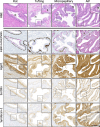Distinct patterns of biomarker expression for atypical intraductal proliferations in prostate cancer
- PMID: 37704825
- PMCID: PMC11522086
- DOI: 10.1007/s00428-023-03643-1
Distinct patterns of biomarker expression for atypical intraductal proliferations in prostate cancer
Erratum in
-
Publisher Correction to: Distinct patterns of biomarker expression for atypical intraductal proliferations in prostate cancer.Virchows Arch. 2025 Jul;487(1):245. doi: 10.1007/s00428-023-03666-8. Virchows Arch. 2025. PMID: 37773453 Free PMC article. No abstract available.
Abstract
High-grade prostatic intraepithelial neoplasia (HGPIN) is a well-characterised precursor lesion in prostate cancer. The term atypical intraductal proliferations (AIP) describes lesions with features that are far too atypical to be considered HGPIN, yet insufficient to be diagnosed as intraductal carcinoma of the prostate (IDCP). Here, a panel of biomarkers was assessed to provide insights into the biological relationship between IDCP, HGPIN, and AIP and their relevance to current clinicopathological recommendations. Tissue samples from 86 patients with prostate cancer were assessed by routine haematoxylin and eosin staining and immunohistochemistry (IHC) with a biomarker panel (Appl1/Sortilin/Syndecan-1) and a PIN4 cocktail (34βE12+P63/P504S). Appl1 strongly labelled atypical secretory cells, effectively visualising intraductal lesions. Sortilin labelling was moderate-to-strong in > 70% of cases, while Syndecan-1 was moderate-to-strong in micropapillary HGPIN/AIP lesions (83% cases) versus flat/tufting HGPIN (≤ 20% cases). Distinct biomarker labelling patterns for atypical intraductal lesions of the prostate were observed, including early atypical changes (flat/tufting HGPIN) and more advanced atypical changes (micropapillary HGPIN/AIP). Furthermore, the biomarker panel may be used as a tool to overcome the diagnostic uncertainty surrounding AIP by supporting a definitive diagnosis of IDCP for such lesions displaying the same biomarker pattern as cribriform IDCP.
Keywords: Atypical intraductal proliferation; Biomarkers; Diagnosis; High-grade prostatic intraepithelial neoplasia; Immunohistochemistry; Prostatic adenocarcinoma.
© 2023. The Author(s).
Conflict of interest statement
D.A.B and J.J.O’L are shareholders for Envision Sciences Pty Ltd and benefit from this company’s research funding. D.A.B and I.R.D.J have a patent WO2014197937A1 that has been licensed by UniSA Ventures to Envision Sciences Pty Ltd for commercialisation. DAB is named as inventor on an additional patent, PCT/AU2020/050925, involving the invention used in this manuscript, which is owned by Envision Sciences Pty Ltd. C.M, J.M.L, A.S, S.P, B.S-Y.U, and I.R.D.J are employed by the University of South Australia using funding from Envision Sciences Pty Ltd.
Figures


References
-
- Netto GJ, Amin MB, Berney DM et al (2022) The 2022 World Health Organization classification of tumors of the urinary system and male genital organs-part B: prostate and urinary tract tumors. Eur Urol 82:469–482. 10.1016/j.eururo.2022.07.002 - PubMed
-
- Hickman RA, Yu H, Li J et al (2017) Atypical intraductal cribriform proliferations of the prostate exhibit similar molecular and clinicopathologic characteristics as intraductal carcinoma of the prostate. Am J Surg Pathol 41:550–556. 10.1097/PAS.0000000000000794 - PubMed
-
- Morote J, Schwartzmann I, Celma A et al (2022) The current recommendation for the management of isolated high-grade prostatic intraepithelial neoplasia. BJU Int 129:627–633. 10.1111/bju.15568 - PubMed
-
- Shah RB, Nguyen JK, Przybycin CG et al (2019) Atypical intraductal proliferation detected in prostate needle biopsy is a marker of unsampled intraductal carcinoma and other adverse pathological features: a prospective clinicopathological study of 62 cases with emphasis on pathological outcomes. Histopathology 75:346–353. 10.1111/his.13878 - PubMed
MeSH terms
Substances
LinkOut - more resources
Full Text Sources
Medical
Miscellaneous

